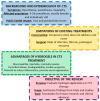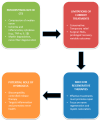Hydrogel-Based Innovations in Carpal Tunnel Syndrome: Bridging Pathophysiological Complexities and Translational Therapeutic Gaps
- PMID: 39852023
- PMCID: PMC11764971
- DOI: 10.3390/gels11010052
Hydrogel-Based Innovations in Carpal Tunnel Syndrome: Bridging Pathophysiological Complexities and Translational Therapeutic Gaps
Abstract
Carpal Tunnel Syndrome (CTS) is a prevalent neuropathic disorder caused by chronic compression of the median nerve, leading to sensory and motor impairments. Conventional treatments, such as corticosteroid injections, wrist splinting, and surgical decompression, often fail to provide adequate outcomes for chronic or recurrent cases, emphasizing the need for innovative therapies. Hydrogels, highly biocompatible three-dimensional biomaterials with customizable properties, hold significant potential for CTS management. Their ability to mimic the extracellular matrix facilitates localized drug delivery, anti-adhesion barrier formation, and tissue regeneration. Advances in hydrogel engineering have introduced stimuli-responsive systems tailored to the biomechanical environment of the carpal tunnel, enabling sustained therapeutic release and improved tissue integration. Despite these promising developments, hydrogel applications for CTS remain underexplored. Key challenges include the absence of CTS-specific preclinical models and the need for rigorous clinical validation. Addressing these gaps could unlock the full potential of hydrogel-based interventions, which offer minimally invasive, customizable solutions that could improve long-term outcomes and reduce recurrence rates. This review highlights hydrogels as a transformative approach to CTS therapy, advocating for continued research to address translational barriers. These innovations have the potential to redefine the treatment landscape, significantly enhancing patient care and quality of life.
Keywords: CTS therapy; biomaterials; carpal tunnel syndrome; functional hydrogels; hydrogels; peripheral nerve injury.
Conflict of interest statement
The authors declare no conflicts of interest.
Figures
Similar articles
-
Utilization of Neurophysiological Classification Systems in Determining Interventions for Patients with Carpal Tunnel Syndrome.Med J (Ft Sam Houst Tex). 2022 Jan-Mar;(Per 22-01/02/03):33-40. Med J (Ft Sam Houst Tex). 2022. PMID: 34940966
-
Carpal Tunnel Syndrome: Rapid Evidence Review.Am Fam Physician. 2024 Jul;110(1):52-57. Am Fam Physician. 2024. PMID: 39028782 Review.
-
Dexamethasone versus Hyaluronidase as an Adjuvant to Local Anesthetics in the Ultrasound-guided Hydrodissection of the Median Nerve for the Treatment of Carpal Tunnel Syndrome Patients.Anesth Essays Res. 2019 Jul-Sep;13(3):417-422. doi: 10.4103/aer.AER_104_19. Anesth Essays Res. 2019. PMID: 31602055 Free PMC article.
-
Surgical versus non-surgical treatment for carpal tunnel syndrome.Cochrane Database Syst Rev. 2024 Jan 8;1(1):CD001552. doi: 10.1002/14651858.CD001552.pub3. Cochrane Database Syst Rev. 2024. PMID: 38189479 Free PMC article.
-
Current concepts of carpal tunnel syndrome: pathophysiology, treatment, and evaluation.J Orthop Sci. 2010 Jan;15(1):1-13. doi: 10.1007/s00776-009-1416-x. Epub 2010 Feb 12. J Orthop Sci. 2010. PMID: 20151245 Review.
Cited by
-
Unlocking nerve regeneration: electrical stimulation and bioscaffolds to enhance peripheral nerve regeneration.Front Neurosci. 2025 May 16;19:1594435. doi: 10.3389/fnins.2025.1594435. eCollection 2025. Front Neurosci. 2025. PMID: 40454247 Free PMC article. Review.
-
A Comprehensive Review of Smart Thermosensitive Nanocarriers for Precision Cancer Therapy.Int J Mol Sci. 2025 Jul 29;26(15):7322. doi: 10.3390/ijms26157322. Int J Mol Sci. 2025. PMID: 40806454 Free PMC article. Review.
-
Gelatin-Based Hydrogels for Peripheral Nerve Regeneration: A Multifunctional Vehicle for Cellular, Molecular, and Pharmacological Therapy.Gels. 2025 Jun 25;11(7):490. doi: 10.3390/gels11070490. Gels. 2025. PMID: 40710652 Free PMC article. Review.
References
-
- Rotaru-Zavaleanu A.D., Lungulescu C.V., Bunescu M.G., Vasile R.C., Gheorman V., Gresita A., Dinescu V.C. Occupational Carpal Tunnel Syndrome: A scoping review of causes, mechanisms, diagnosis, and intervention strategies. Front. Public Health. 2024;12:1407302. doi: 10.3389/fpubh.2024.1407302. - DOI - PMC - PubMed
Publication types
LinkOut - more resources
Full Text Sources
Research Materials




